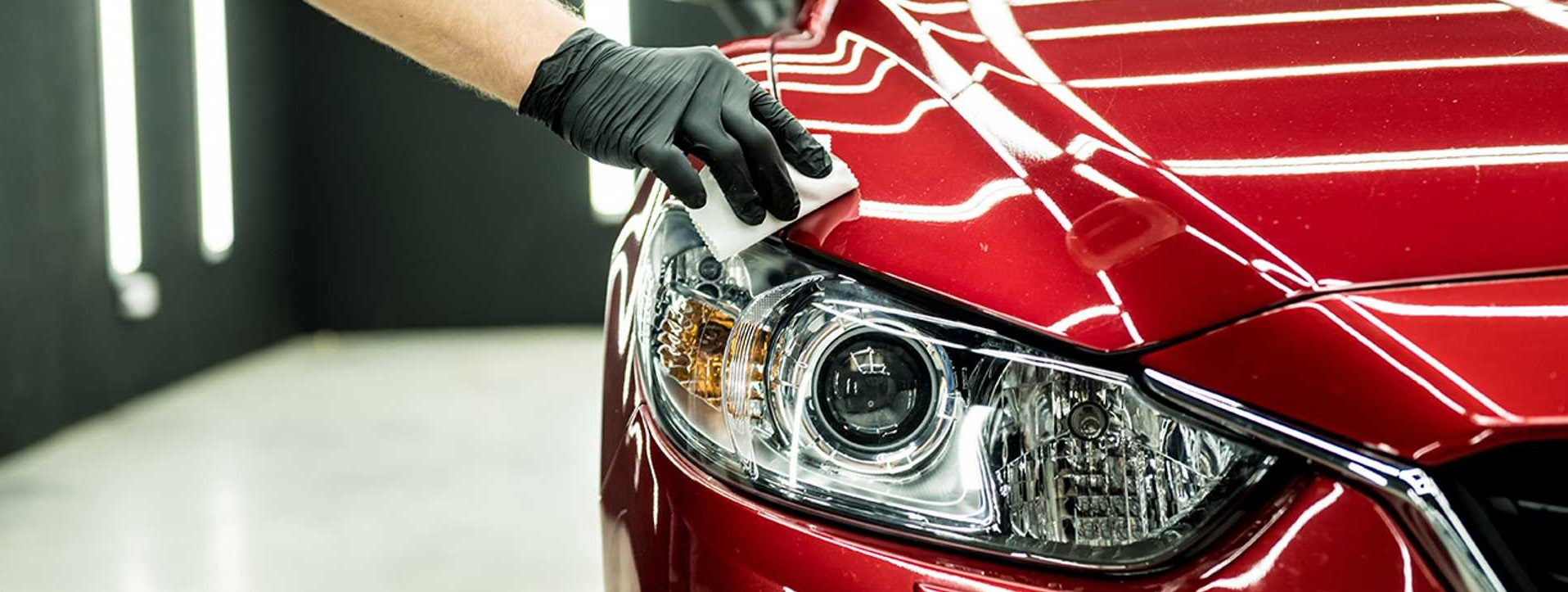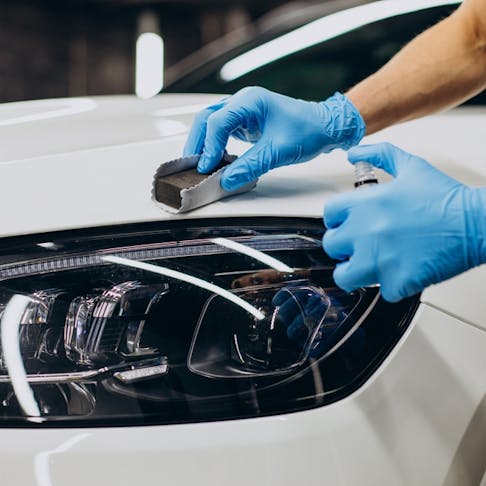Discovering the Scientific Research Behind Car Ceramic Coating and Its Safety Features
The scientific research of car ceramic coating provides a fascinating study in sophisticated automobile protection. Made up mainly of silicon dioxide and polymers, these coatings form a durable bond with automobile paint. This communication enhances toughness versus ecological threats while supplying hydrophobic advantages. Nonetheless, the intricacies of just how these finishings job and their long-lasting benefits remain much less recognized. Unpacking these details exposes why ceramic finishes are coming to be a recommended selection for vehicle care
What Is Ceramic Coating?
Ceramic coating is a fluid polymer that chemically bonds to the surface of a lorry's paint. This sophisticated protective layer enhances longevity and supplies exceptional resistance to environmental factors. Unlike standard wax or sealers, which supply momentary defense, ceramic finishes develop a lasting shield that can endure rough problems such as UV rays, acidic impurities, and severe weather condition. When used appropriately, the coating creates a hydrophobic surface, triggering water to grain and slide off, which helps in keeping the vehicle's cleanliness. In addition, it supplies enhanced gloss and depth to the paint, making the vehicle appear even more sleek and dynamic. The application process usually involves detailed surface area prep work, including cleansing and polishing, to assure peak bonding. Because of this, ceramic finishings are becoming increasingly popular among car fanatics and those seeking to shield their investments, promising to maintain the lorry's visual appeal while lowering the frequency of maintenance.
The Composition of Ceramic Coatings
The complex solution of ceramic finishings largely contains silicon dioxide (SiO2), which is originated from natural resources like quartz and sand. This key part supplies the structure for the coating's toughness and protective qualities. In enhancement to SiO2, ceramic finishings frequently include numerous polymers and additives that boost adhesion, adaptability, and resistance to ecological factors. These compounds function synergistically to develop a durable obstacle against pollutants such as dirt, chemicals, and UV rays.Furthermore, some formulations integrate titanium dioxide (TiO2) or other nanomaterials, which can augment the coating's hydrophobic residential properties, causing improved water repellency. The precise structure can vary significantly among suppliers, influencing performance and longevity. Inevitably, the mix of these elements finishes in a safety layer that not just improves the aesthetic allure of cars however also offers to lengthen their lifespan by securing the surface area from potential damages.
Just How Ceramic Coatings Work
Understanding exactly how ceramic finishes function entails exploring their chemical structure, which contributes to their safety high qualities. The application process is crucial for accomplishing suitable outcomes, while longevity and toughness variables figure out the coating's effectiveness over time. With each other, these aspects highlight the benefits and efficiency of ceramic coverings for automobile protection.
Chemical Make-up Explained
While lots of car owners look for long-lasting security for their cars, the chemical composition of ceramic finishes plays an essential role in their effectiveness. These finishes primarily contain silicon dioxide (SiO2), which is stemmed from all-natural minerals. This compound forms a solid bond with the car's paint, creating a durable, protective layer. In addition, many ceramic coatings include titanium dioxide (TiO2), boosting their hydrophobic residential or commercial properties and resistance to UV rays. The visibility of polysiloxanes can additionally boost adaptability and longevity. With each other, these aspects add to the coating's ability to repel water, dust, and contaminants, while likewise supplying a high-gloss surface. Understanding this chemical foundation helps car owners appreciate the durable defense offered by ceramic coverings.
Application Process Review
Applying ceramic finishings entails a careful procedure that guarantees perfect bonding and protection for the vehicle's surface. Originally, thorough cleaning and purification of the car's outside are performed to get rid of dust, gunk, and previous waxes. This action validates that the surface area is without pollutants that could impede attachment. Following this, the paint is frequently polished to enhance clarity and eliminate any type of blemishes. When prepared, the ceramic coating is used in little areas using an applicator pad, enabling consistent protection. The coating is then left to heal, developing click this a solid chemical bond with the surface area. Appropriate treating times and problems are essential, as they verify the coating attains its optimum efficiency and protective qualities.
Durability and Longevity Elements
Ceramic coverings are designed to give resilient defense through their innovative chemical composition, which creates a durable obstacle versus ecological pollutants. The durability of these layers is influenced by aspects such as the density of the application, the quality of the product, and the conditions under which the automobile is exposed. High-quality ceramic layers can last a number of years, resisting scratches, UV rays, and chemical discolorations. Appropriate maintenance, including routine washing and periodic reapplication, can even more boost durability. Furthermore, environmental elements like climate and exposure to toxins can influence the lifespan of the coating. On the whole, when applied and maintained correctly, ceramic finishings offer exceptional resilience, making them a popular selection for car fanatics seeking to protect their car's look.
Hydrophobic Properties and Water Repellency
Hydrophobic properties are a hallmark of quality car ceramic finishes, considerably enhancing the vehicle's surface performance. These finishings create a molecular bond with the car's paint, leading to a surface that repels water efficiently. When water enters call with a ceramic-coated surface area, it beads up and rolls off, reducing the amount of fluid that remains on the paint. This behavior not just adds to a visually pleasing appearance however additionally decreases the buildup of contaminants such as dust, gunk, go to the website and road salts.The improved water repellency causes less complicated cleansing and upkeep, as less initiative is called for to get rid of undesirable materials. Furthermore, the hydrophobic nature of ceramic coverings aids in preventing water places, which can mar the coating of uncoated surfaces. In general, the consolidation of hydrophobic residential or commercial properties in ceramic layers plays an essential role in preserving the vehicle's pristine appearance while streamlining maintenance.
Defense Versus Scratches and UV Damages
Car ceramic finishings supply considerable security versus scratches and UV damage. The scrape resistance device produces a long lasting layer that absorbs effects, while the UV shielding benefits aid maintain the lorry's paint integrity gradually. Together, these functions contribute to a longer-lasting and visually attractive coating.
Scrape Resistance Device
Making use of sophisticated technology, ceramic finishings give a durable shield versus scrapes and UV damage, boosting the longevity and appearance of vehicle surface areas. The scrape resistance mechanism of these layers is credited to their special molecular framework, which develops a durable bond with the lorry's paint. This bond develops a hard, protective layer that can soak up effects and resist abrasions. Additionally, the smooth surface area of the coating reduces rubbing, making it hard for impurities to stick and trigger scratches. The chemical make-up of ceramic coverings frequently consists of nanoparticles that reinforce the protective layer, additional boosting its strength. Cars treated with ceramic finishes exhibit considerably improved scratch resistance compared to typical wax or sealers, ensuring a pristine surface over time.
UV Shielding Advantages
The protective qualities of ceramic coatings prolong past scratch resistance to include considerable UV shielding benefits. These coatings produce a durable barrier that reflects dangerous ultraviolet rays, guarding the car's paint and underlying materials. Prolonged direct exposure to UV radiation can cause fading, oxidation, and damage of the paint surface. he has a good point By including ceramic coatings, automobile proprietors can successfully minimize these risks, protecting the visual appeal and integrity of their vehicles. Additionally, the UV obstructing properties add to boosted long life, minimizing the frequency of painting and maintenance. Ultimately, the integration of ceramic finishings provides a comprehensive option for securing cars from the harmful results of sun exposure, guaranteeing a continual, lively appearance gradually.
The Longevity and Upkeep of Ceramic Coatings

Frequently Asked Questions
Can Ceramic Coating Be Applied to Any Kind Of Kind of Automobile?
Ceramic coating can be put on various kinds of cars, consisting of cars and trucks, vehicles, and bikes. Surface prep work and compatibility with certain materials are essential for excellent bond and efficiency of the coating.
Just How Much Does Ceramic Coating Typically Price?
Ceramic coating normally sets you back between $500 and $2,000, depending upon elements such as lorry size, coating quality, and specialist application. The financial investment can give long-lasting defense and improve the automobile's look in time.

Is Specialist Application Necessary for Finest Results?
The need of specialist application often depends on preferred results. Specialists commonly guarantee correct surface area prep work and application strategies, causing excellent bonding and durability of the coating, which may be testing for inexperienced people to achieve.
Can Porcelain Coatings Be Eliminated or Repaired?
Ceramic finishings can be removed or fixed, though the procedure might require specific solvents or techniques - Ceramic Coating Newark. Correct elimination is necessary to prevent damages to the underlying surface area, emphasizing the importance of specialist support for suitable outcomes
Exactly How Does Ceramic Coating Contrast to Typical Wax?
The contrast between ceramic coating and conventional wax discloses that ceramic layers provide remarkable resilience, improved protection versus environmental pollutants, and longer-lasting luster, while wax requires much more regular application and provides less general resistance to damages.